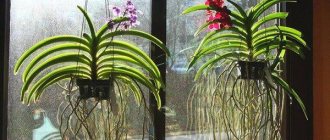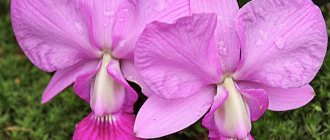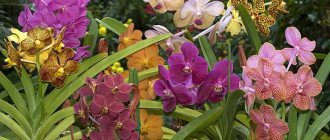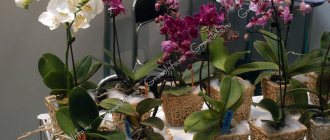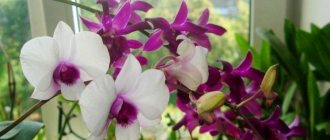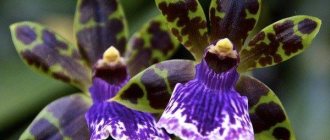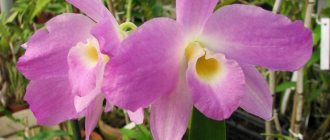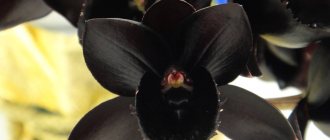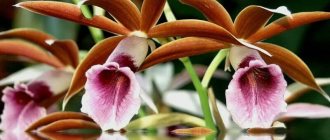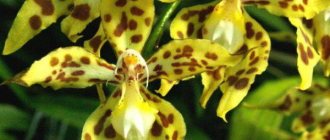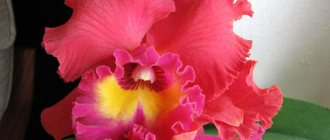A masterpiece of hybridization, the Beallara orchid
Beallara is truly a masterpiece of hybridization.
There are up to 15 large flowers on long (up to 50 cm) peduncles emerging from the leaf axils. Large flowers, up to 20 centimeters in diameter, have many color variations. A distinctive feature of the beallar is the unique pattern of spots on the sepals and lip. The shape of bealara flowers resembles stars. The flowering of beallara is a unique and fascinating spectacle. The undeniable advantage of this orchid is that at the same time one bulb can produce 2 peduncles at once. To create beallara, breeders took the best traits of brassia, miltonia and oncidium. The resulting orchid turned out to be not only beautiful, but also easy to care for.
At home, caring for beallara will not cause any difficulties even for novice orchid collectors.
Temperature
Since beallara is not a natural species, it is difficult to name the optimal temperatures for its comfortable existence. There is nothing to focus on. A huge number of different hybrids has led to the fact that the range of temperatures favorable for beallara has expanded. There are cold-loving and heat-loving hybrids. It is almost impossible to find out which one your beallara belongs to when purchasing, so you will have to observe your plant and calculate them experimentally.
Estimated temperatures are 18-35 degrees during the day and 16-20 at night. For the comfortable existence of this orchid, you will have to take care to reduce temperatures by at least 4 degrees at night. The lack of temperature difference affects the flowering frequency of beallara.
Necessary lighting parameters for Beallara
The beallar orchid is light-loving and tolerates direct sunlight well. But this does not mean that immediately after purchasing you can put the pot in the sun. In stores, orchids are not given good lighting, so gradually accustom the orchid to the bright sun.
In winter, it is advisable to extend the beallara daylight hours using a fluorescent lamp.
Air humidity and watering Beallary
The key to successfully growing any orchid is a high level of humidity, and beallara is no exception. Therefore, equip the location of the beallar with containers with wet expanded clay.
Water beallara as the substrate dries. It’s not scary if the orchid sits in completely dry bark for a couple of days. Stagnation of water in a pot is destructive. Make sure that after watering the remaining water flows out of the pot easily. To do this, you will have to make many holes across the entire surface of the pot. The best watering method is a hot shower. The water temperature must exceed the temperature of the human body. During flowering, it is not recommended to wet the flowers. This may cause brown spots to appear on their surface.
Which sibling should Beallara be transplanted into?
There is no need for frequent transplants. There are only two reasons for them. Beallara is replanted in case of decomposition of the substrate (the bark has turned into dust) and as it grows.
The composition of the substrate can be as follows: chopped fern roots, small pieces of peat, sphagnum and bark. There is no need to compact the substrate. The roots must have access to air.
Life stages
The beallar orchid does not have a dormant period, but can go into hibernation in the winter. For this, a long absence of bright lighting will be sufficient. There is also no clearly defined period for increasing green mass. Beallara is capable of simultaneously producing new shoots and peduncles. Problems of identifying roots and peduncles are not relevant for this orchid. New shoots appear in the form of small bushes, over time a bulb forms at the base of them. The peduncle grows exclusively from the leaf axil.
Cumbria Burrageara. Generalized experience.
Orchid zygopetalum. caring for zygopetalum at home
In honor of the next flowering, I decided to write a post about my cambria “from A to Z”. Perhaps some information will seem primitively simple, but for those who have not encountered such an orchid at all and are thinking about purchasing it, everything will probably be interesting.
To begin with, a photo of the current flowering, I’ll brag so to speak)))
This type of orchid does not have one growth point, unlike, for example, phalaenopsis, but many. These growing points are called pseudobulbs.
The plant can be divided periodically, but the more pseudobulbs together, the stronger the plant. It is also believed that Cambria begins to bloom when there are at least three bulbs.
On the sides of each pseudobulb, 2 peduncles grow from the leaf axils, one on each side, not necessarily simultaneously. This bulb will not bloom again, we need to wait for new ones. In my experience, new pseudobulbs are ready to flower even at very small sizes. Here, for example, in the current flowering. In the photo, I indicated with an arrow a young bulb of rather modest size, from which comes a quite tall and abundantly flowering peduncle.
The roots of Cambria are completely different from the roots of Phalaenopsis; they are more similar to the standard roots in our minds.
Now about my experience. I transplanted the Cambria into a transparent pot, it’s easier for me, you can always see whether everything is normal with the roots, whether they are growing or, on the contrary, darkening and dying. I covered it with very, very fine bark, which was left in excess as unnecessary from the phalaenopsis, for which I select the largest pieces. Replanting is a rather labor-intensive process: the roots are thin, there are many of them, very often in the “factory” configuration these roots are tightly entangled with sphagnum, which, of course, must be removed as much as possible.
From lack of moisture, pseudobulbs become wrinkled, but this is not critical. Leaves crumpled like an accordion hint more at a serious lack of moisture; this is worth thinking about. But again, after I transplanted the cambria into a transparent pot, the leaves become less deformed into accordion shapes.
The principle of watering is simple: the bark is dry - you can water it. Unlike watering phalaenopsis, here I do not wait for the substrate to completely dry out; if very little condensation is visible on one side, then I can already water it. Sometimes the interval between waterings takes 7 days, sometimes 10, and sometimes 2 weeks, in general, like all orchids, everything is individual.
With fertilizer, everything is also quite standard: from the end of February to September I fertilize every third watering, and also when planting flower stalks.
Everything is simple to the point of primitiveness.
Another observation - I noticed that my cambria is always covered in flowers at the New Year tree. Second flowering usually occurs in summer
But, I think, when there are more bulbs, even more new ones will grow from them at the same time, then there will be even more flowering. These are Napoleonic dreams)))
Although basically yes, the rule is this: the more powerful the plant, the more abundant the flowering. This is why many do not share sympodials in principle.
Cambria orchid
Cambria is the trade name of a fairly numerous genus, the representatives of which are considered to be hybrids created by crossing plants from such genera as Brassia, Miltonia, Odontoglossum and some others. Also in flower shops, this plant is often called Aliceara, Bakerara, Beallara, while in the scientific literature it is called ×Degarmoara.
Plants of this genus have a sympodial growth pattern. Thus, the growth of young shoots occurs on a horizontally located shortened stem (rhizome). As they grow, old shoots die off. Oval developed pseudobulbs have a fusiform or flattened shape. On the surface of the thin roots there is a layer of velamen, which has a porous structure. From the upper part of the pseudobulbs grow 2 or 3 green leaves, which reach 50 centimeters in length and have a belt-like or broadly lanceolate shape. The central vein is clearly visible on the surface of the leaf, while the leaf blade itself is slightly folded inward along it.
This orchid can bloom at any time of the year. Multi-flowered peduncles appear from the axils of the lower leaves, most often they are straight, but sometimes they are branched. Such peduncles can reach 60 centimeters in length and contain up to 50 relatively large flowers (diameter up to 7–10 centimeters). Zygomorphic flowers have 5 sepals, which are connected in the shape of an asterisk, and they also have one clearly visible and fairly large lip (modified petal). The color of the flowers can be different, but most of them are variegated (speckles, stains, spots or patterns). Some of the flowers are quite fragrant.
Reanimation of cambria without a root system
If Cambria is not properly cared for, its root system may begin to rot. But this can be completely corrected.
So, we take our flower out of the pot, carefully examine the roots, and remove the rotten ones. Whole ones need to be treated with foundationazole. At the same time, we are preparing a new pot and a new substrate. To prepare it you will need polystyrene foam and new bark. Don't forget to rinse, boil and dry it properly. We replant the cambria as described above and secure it. A plant without roots does not need watering, but you need to spray it a couple of times a week. For these purposes, a fine spray is used. A foggy cloud should form around the flower, but make sure that water does not flow down its leaves. Sometimes, instead of water, you can use the same foundation in the form of a solution. New roots will take quite a long time to grow, but this time will be enough for you to draw conclusions and not repeat your mistakes.
Trimming
In general, Cambria does not need it. It may only be needed if the plant is sick, because diseased parts threaten the condition of the entire flower. You can also periodically remove dried shoots. Instruments (this can be a thin blade or knife) must be sterile. If you have several cambrias, disinfect your tools after each pruning procedure. For disinfection, you can use manganese in the form of a solution, as well as an alcohol wipe. The cut can be treated with cinnamon or crushed coal. It is very important not to overdo it when removing flower stalks.
After Cambria blooms, it is recommended to trim its peduncle. Only brown or yellow flower stalks that have hardened after flowering are removed. They are removed to the very base, completely. For these purposes, sterile instruments are also used, for example, pruners or a knife. Leave a shoot about a centimeter long. We process the cut in the same way: using charcoal or cinnamon. You can also use garden varnish. It is also advisable to remove pseudobulbs.
Flowering period
It usually occurs in winter or autumn. This happens less often in early summer. Some varieties of Cambria can bloom several times a year. The fact is that pseudobulbs can form new shoots almost constantly.
It blooms magnificently. The flowers are lined up in a chain and bloom at the same time. Often a flower has several peduncles at once.
By the way, you can cause re-blooming yourself. To do this, the flower is placed in a cold room for a maximum of two weeks. The temperature here should be from 13 to 15 degrees above zero. To make the pseudobulb ripen faster, try not to water the cambria. Or do it extremely rarely. After two weeks in extreme conditions, the cambria can be returned to its usual place. As soon as you see the first peduncle in the leaf axils, you can resume watering. But don’t overdo it, otherwise the orchid will change its mind about blooming.
Important! This type of shaking is only suitable for adult plants that have reached two years of age. A young orchid that has not yet gained strength may be damaged by this method.
Rest period
It does not occur very clearly in the flower. It begins on days when the air temperature drops and daylight hours begin to shorten. After flowering, it is worth forcing the flower to enter this period artificially. We just stop fertilizing and watering, and move the pot with cambria to a cold place.
If this is not possible, we leave it in its usual place, but the air here should be more humid. In addition, the flower will need additional lighting. During the dormant period, watering it once every couple of weeks is sufficient. This will help maintain the healthy appearance of the green mass of Cumbria, and nothing more is needed for now. Sometimes watering can be replaced by spraying. What you can’t do now is fertilize the flower.
Caring for a Cambria orchid at home
Caring for orchids is not as easy as, for example, dendrobiums or phalaenopsis. However, if you have several skills and know the basic rules of care, you can safely grow this beautiful flower at home.
Illumination
It needs bright lighting, but the plant needs to be shaded from direct sunlight. It will feel best on windows of eastern and western orientation. If the cambria is placed on a south-facing window, then it should be slightly shaded from the scorching midday sun.
Cambria propagation
This type of orchid can be propagated only in one way - by dividing the bush. This is done after the Cambria has finished its flowering period. In parallel with this, the plant is transplanted.
We prepare the pots and substrate in advance. You must first disinfect them using a solution of potassium permanganate.
The soil in the pot is moistened, and we carefully remove the cambria from it. We remove the roots from the soil.
We separate the bush into several small parts with roots belonging to each part. Each part should have three pseudobulbs and three sprouts.
It is very important to follow disinfection rules during this process. All instruments must be treated with potassium permanganate or alcohol, all cuts and damage (if any) are treated with charcoal or cinnamon.
Carefully inspect each part of the cambria; remove damaged and diseased areas immediately.
We replant the separated parts of the orchid into new pots, but do not bury them too deep into the ground. Also, you should not cover the ground with moss. We fix the new plant well in the pot. The soil can be moistened before transplanting. Just spray it with soft water.
After seating, Cumbrias need temporary rest. Cambria should not be watered for the next 14 days; the temperature in the room should be stable and uniform. Direct sunlight is prohibited during this period. In addition, the orchid cannot be moved to another place for the next couple of weeks. The soil cannot be fertilized or loosened yet.
The first feeding is carried out after the cambria enters the phase of active budding and growth.
It is better to take ceramic pots without glaze. We distribute the roots evenly along the wall of the container; do not tuck them.
When choosing the size of the pot, be guided by the condition and size of the orchid root.
Main types
Listed below are those species that are most popular among flower growers and can be easily purchased at a flower shop and grown in your apartment.
Vuylstekeara
This is a complex hybrid obtained by crossing Cochlyodes, Miltonia and Odontoglossum. This graceful orchid can have from 5 to 20 fairly large flowers on a peduncle, which are most often colored red, pink or yellow. It blooms for quite a long time, about 8 weeks. The beginning of flowering occurs at the end of winter and the beginning of spring.
Burrageara
This hybrid is even more complex than the previous one. It was created by crossing plants from genera such as Cochliodas, Oncidium, Miltonia and Odontoglossum. The color of the flowers is a variety of combinations of red and yellow shades. The flowers are quite fragrant and their scent is similar to a rose. Flowering occurs in mid-winter.
Beallara
This hybrid was obtained by crossing Brassia, Odontoglossum, Miltonia, and Cochliodae. Flowering occurs from mid to late summer. The flowers have a cream color or pink-white-purple, as a rule, on their surface there is a very large number of different dots and specks of dark color.
Colmanara
This hybrid appeared as a result of crossing Oncidium, Odontoglossum and Miltonia. The plant blooms for quite a long time, 1–3 months. The main color of the flowers is various shades of yellow and red.
Degarmoara
This hybrid was the result of crossing Odontoglossum, Brassia and Miltonia. It has quite large flowers, so their diameter can reach 10 centimeters. Flowering can begin at any time and depends on the maturation of the pseudobulbs. Flowers can have a wide variety of shapes and colors.
Odontocidium
This hybrid is quite simple and was obtained by crossing Oncidium and Odontoglossum. There are up to 50 medium-sized flowers on long peduncles. The flowers can be colored in a variety of combinations of yellow and red, and there are a variety of dark patterns and dots on their surface.
Odontioda
This hybrid is also not complicated. It was obtained by crossing Odontoglossum and Cochlyodes. The color of the flowers is a variety of combinations of yellow and red flowers.
How to care for an orchid
Depending on the type of crop, proper care must be provided and provided. They do not differ much from each other, and therefore they have been combined into a common table.
Temperature
Cumbria enjoys moderate temperatures throughout the year. Keep the flower in summer at 17 - 20 degrees. If these values are exceeded, the flower begins to grow more slowly, buds form poorly, and leaves may begin to dry out. At night it is not recommended to allow a difference of more than five degrees.
Large fluctuations can send the plant into shock. In winter, you need to organize a rest period for Cambria. Set and maintain a constant temperature between 14 and 16 degrees. Rest helps the orchid gain strength and recover before the next season.
Lighting
The star orchid is one of the light-loving crops. It is recommended to grow it on a windowsill on the bright side. But direct ultraviolet radiation should not be allowed to reach the plant. Bright ultraviolet light burns leaf blades, the decorative effect is lost, and the process of photosynthesis deteriorates.
When an orchid is grown on the sunny side, you need to make a screen. A frame with a stretched thin cloth or gauze will do. In winter, when there is little sunlight, you need to move the cambria to the brightest place in the house. From the shadow, the flower may begin to stretch and stop blooming. The recommended daylight limit for the entire year is 10 hours. If there is not enough light, you can place a pot with an orchid under a phytolamp.
Air humidity
The conditions for keeping Cumbria require high air humidity. It is recommended to always keep humidity between 80 – 90%. To do this, you need to spray the flower regularly.
In this case, liquid retention on shoots or leaf blades should not be allowed. They begin to deteriorate and rot. An open jar or pot of clean water should be placed next to the container. You can put wet expanded clay in the pan.
Medicinal plants, folk recipes. Health, beauty, nutrition, plants.
Side Column
Side Column
Popular articles
- Sakura is not just a Japanese cherry – 39
- Nightshade (SOLANUM) - “Jerusalem cherry” or “coral tree” - 34
- Poisonous plants (photos with descriptions) - 33,366 views
- Beautiful orchids – 31
- How plants overwinter - 29
- SCINDAPSUS - "devil's ivy" in English - 28,375 views
- Such a different mess. At what age and what kind of porridge can babies be given - 26
- Dates – healthy sweets – 25
- Why do leaves change color in autumn? — 25
- Three ways to grow bonsai: from seeds, cuttings and propagation by air layering - 24
Beallara is an easy-to-care orchid
Beallara is an intergeneric hybrid (parents of the orchid: Brassia/Cochlioda/Miltonia/Odontoglossum), it is suitable for those who have just decided to grow orchids, since it is a plant from the group of oncidium hybrids that is quite suitable for indoor conditions. Beallara flowers are collected in several pieces on a high peduncle reaching up to 50 cm in height. The orchid is unpretentious, easy to grow and blooms easily. The pseudobulbs are elongated, round, and bear two dense leaves at the top.
Content temperature
Beallara prefers moderately warm temperatures, in the summer within +22-26 degrees. Can withstand short periods of heat well. In winter, cooler conditions are needed; the temperature at this time of year is +15-18 degrees. It is necessary to create a year-round temperature difference of 3-5 degrees, so it is better to keep the plant on the windowsill.
Lighting
Windows are suitable, facing west or east. Beallara loves bright sunlight. It can tolerate direct morning or evening sun, which causes the bulbs to begin to turn red, but in the fall they again acquire a green tint. But at lunchtime the plant needs to be shaded from direct sunlight. Lack of lighting will affect the pseudobulbs - they will grow small, which is why flowering will be weak or may not occur at all.
Humidity , watering and fertilizing
Beallara is suitable for moderate air humidity - 50-60%. Too high humidity can lead to fungus (in this case, increase ventilation). The leaves can sometimes be sprayed or wiped with a damp sponge. During active growth, the plant must be watered regularly and do not allow the substrate to dry out. Feed once every two weeks with a special fertilizer for orchids or a regular fertilizer for indoor plants (in this case, the concentration of the solution must be reduced by 5 times). After flowering ends, the plant forms a young pseudobulb - the orchid does not grow and a dormant period begins. At this time, fertilizers are not applied and watering is reduced.
If you want an orchid, take a closer look at beallar
In addition to the well-known and popular phalaenopsis, novice orchid lovers can recommend beallara, a plant from the group of oncidium hybrids that is quite suitable for indoor conditions.
Its large, elegant flowers, collected in several pieces on a high peduncle, will delight both beginners and experienced gardeners. Most often in stores you can find the Tahoma Glacier beallara; occasionally you come across other hybrids. An adult beallara is a slightly “spread-legged” jacket 30-50 cm in height. The pseudobulbs are large, elongated, with two dense leaves at the top. The orchid is unpretentious, easy to grow and bloom.
Lighting
Beallara loves bright sunlight and can tolerate direct morning and evening sun (this causes the pseudobulbs to often turn red in the summer, but in the fall they restore their green color). At lunchtime, it is better to shade the orchid from the hot rays of the sun. Windows with western and eastern orientation are ideal for growing. With insufficient lighting, young pseudobulbs grow smaller, and flowering will be weak or not at all.
Temperature
Beallara needs to be kept moderately warm. In summer, the optimal temperature for it is within +22-26 degrees. Tolerates short periods of heat well. In winter, cool conditions are desirable, +15-18 degrees. A daily temperature difference of 3-5 degrees is required all year round, but it is usually created naturally on the windowsill.
Air humidity
Beallara is content with a humidity of 40-60%. A sign of insufficient air humidity is young growth like an accordion. However, too high humidity is not good - there is a high probability of fungal diseases, so ventilation should be increased. My plants thrive at 50% humidity. I don’t spray them, only sometimes I wipe the leaves with a soft cloth or wash them with a stream of warm water from the shower.
Watering and fertilizing
During active growth, I water the beallara often and abundantly, and do not allow the substrate to dry out. I feed it once every two weeks with a specialized fertilizer for orchids or a regular fertilizer for indoor plants, reducing the recommended concentration of the solution by 4-5 times. At the end of flowering, as soon as the plant has formed a young pseudobulb, a short period of rest begins - the orchid does not grow. At this time, I reduce watering and do not apply fertilizer.
Beallara can bloom at any time of the year. Peduncles appear from the axils of the formed pseudo-bulbs. The flowers of some beallars have a scent.
Transplantation and propagation
The best time to replant is the period immediately after flowering and until the new shoots begin to develop their own roots. Overgrown specimens are divided. It is better when the division consists of three bulbs. For planting, select both transparent (convenient to observe the root system and navigate watering) and opaque plastic pots. Since the plants themselves are powerful, it is preferable to place them in ceramic pots.
Medium-fraction pine bark (2-2.5 cm) is used as a substrate, pieces of coal and chopped sphagnum are added. But I prefer planting in clean bark, and lay the moss in a 1.5-2 cm layer on the surface of the substrate.
Category: Medicinal indoor plants
Forum of flower growers Frau Flora
About growing indoor and garden plants; discussion of species, varieties, diseases, pests.
Moderator: kirina17
Post by solnze » Sep 30, 2011, 01:48 pm
Beallara - Beallara My Beallara has bloomed Peggy Ruth
Re: Bellara
Post by Jess » Sep 30, 2011 3:11 pm
Re: Bellara
Post by solnze » Sep 30, 2011, 03:18 pm
Re: Bellara
Post by Lucina » 30 Sep 2011, 15:46
Re: Bellara
Post by solnze » 01 Oct 2011, 23:26
Re: Bellara
Post by solnze » 14 Oct 2011, 21:11
Re: Bellara
Post by solnze » 14 Oct 2011, 21:20
Re: Bellara
Post by Lucina » 14 Oct 2011, 21:20
Re: Bellara
Post by solnze » 16 Oct 2011, 13:25
Re: Bellara
Post by vega1981 » 17 Oct 2011, 16:09
Re: Bellara
Post by solnze » Sep 13, 2012, 03:23 pm
This year, due to the heat, several buds dried out
Re: Bellara
Post by Lucin » 13 Sep 2012, 15:26
Re: Bellara
Post by Passific » 13 Sep 2012, 15:40
Re: Bellara
Post by vega1981 » 08 Oct 2012, 10:03
Re: Bellara
Post by solnze » 08 Oct 2012, 22:49
Re: Bellara
Post by Mihail M » 28 Nov 2012, 17:53
Beallara Marfitch 'Howards Dream'
Re: Bellara
Post by Lucina » November 28, 2012, 6:08 pm
Re: Bellara
Post by solnze » 28 Nov 2012, 20:03
Re: Bellara
Post by svetochka » Nov 28, 2012, 10:17 pm
Re: Bellara
Post by Mihail M » Nov 28, 2012, 11:59 pm
Not all the flowers on this peduncle have bloomed yet; two buds are hiding behind them. The plant is fertile, produces several flower stalks:
Unpretentious, blooms consistently, flowers are large.

